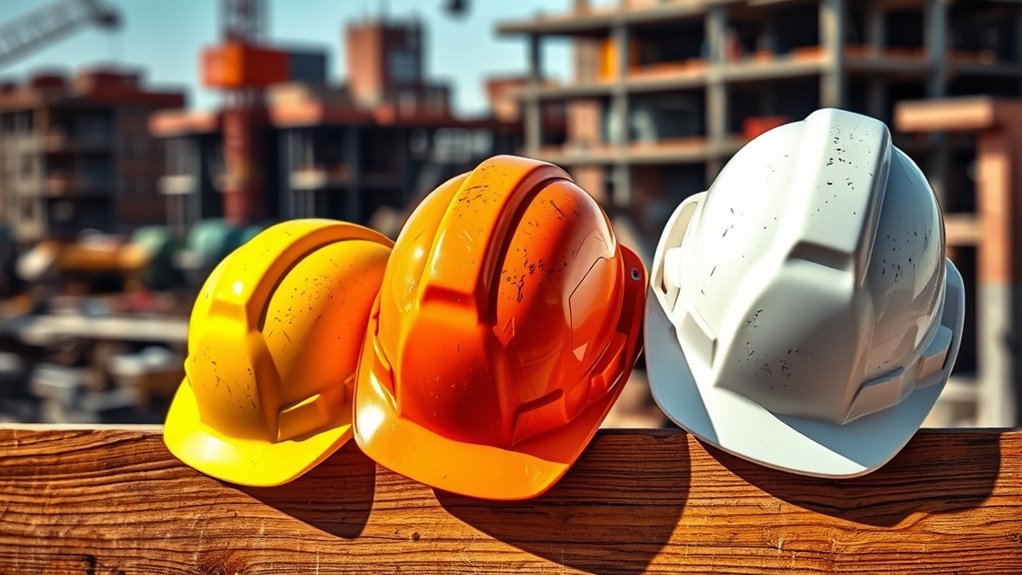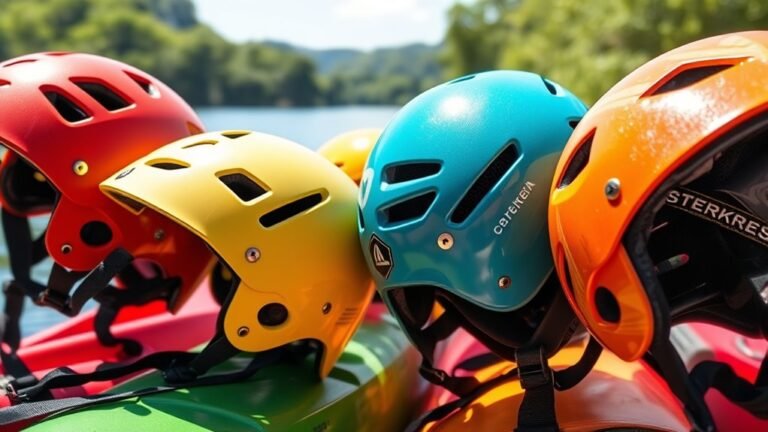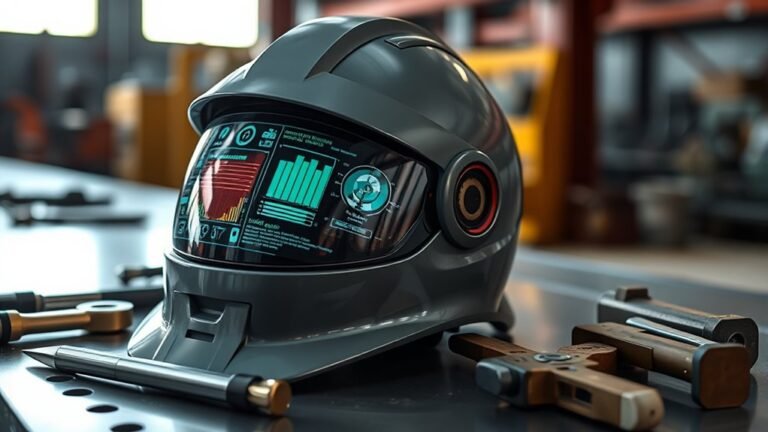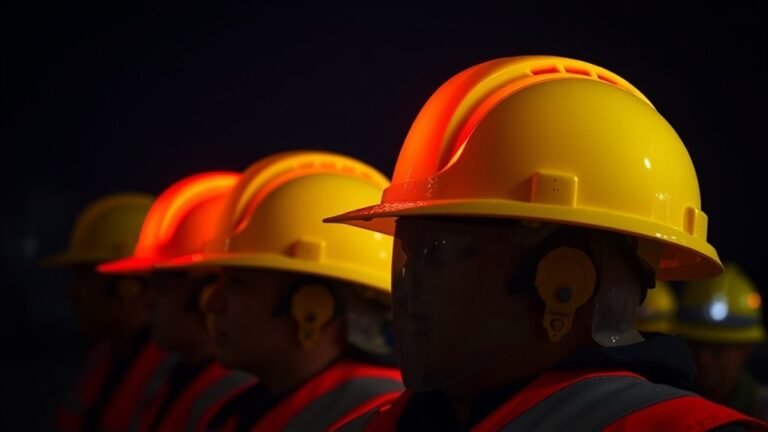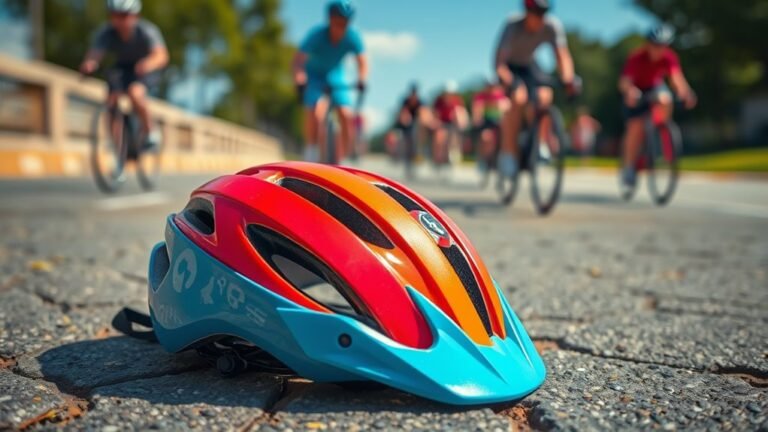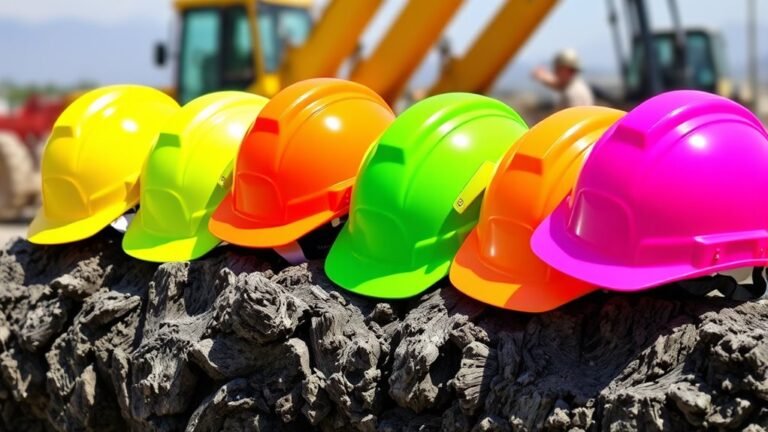Best Helmets for Construction Workers
When choosing the best helmets for construction workers, prioritize impact resistance and comfort. Look for adjustable straps and foam padding for a secure fit. Hard hats provide superior protection from falling objects, while bump caps are suitable for minor risks. Verify the helmet meets safety certifications like ANSI Z89.1 or CSA Z94.1 for maximum security. Regular maintenance and proper care can extend its lifespan considerably. Discover more about features and brands to keep you safe on the job site.
Importance of Safety Helmets in Construction
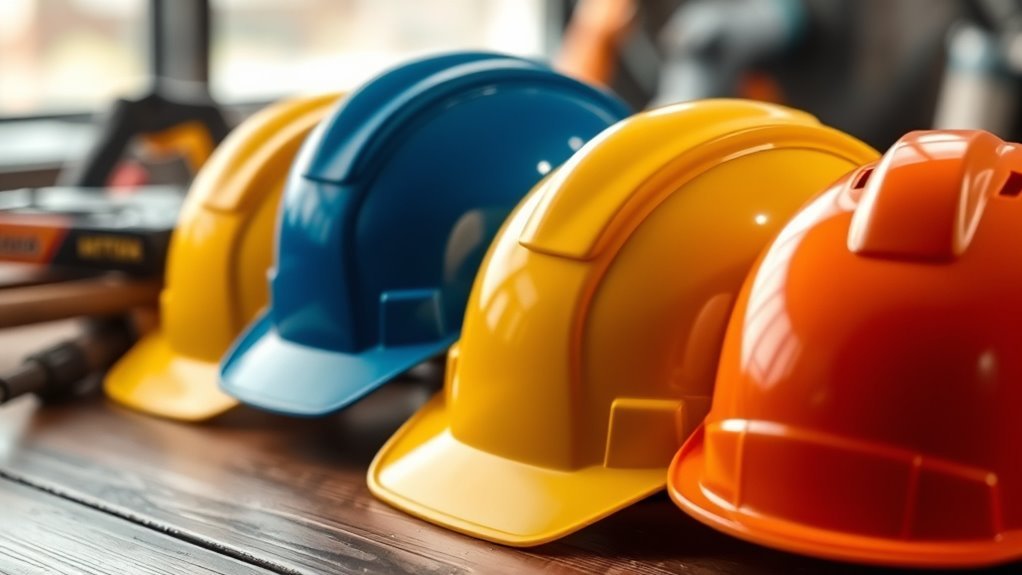
When you’re on a construction site, the importance of safety helmets can’t be overstated. These helmets are your first line of defense against head injuries, which can occur from falling objects or accidental bumps. You need to prioritize helmet durability; a well-constructed helmet can withstand harsh conditions and provide reliable protection. Choosing a helmet that meets rigorous safety standards guarantees that you’re equipped for the unpredictable nature of construction work. By wearing a safety helmet, you not only protect yourself but also promote a culture of workplace safety among your peers. Remember, taking precautions like wearing a helmet isn’t just about compliance; it’s about preserving your freedom to work without the constant worry of injury. Stay safe, stay free.
Key Features to Look For
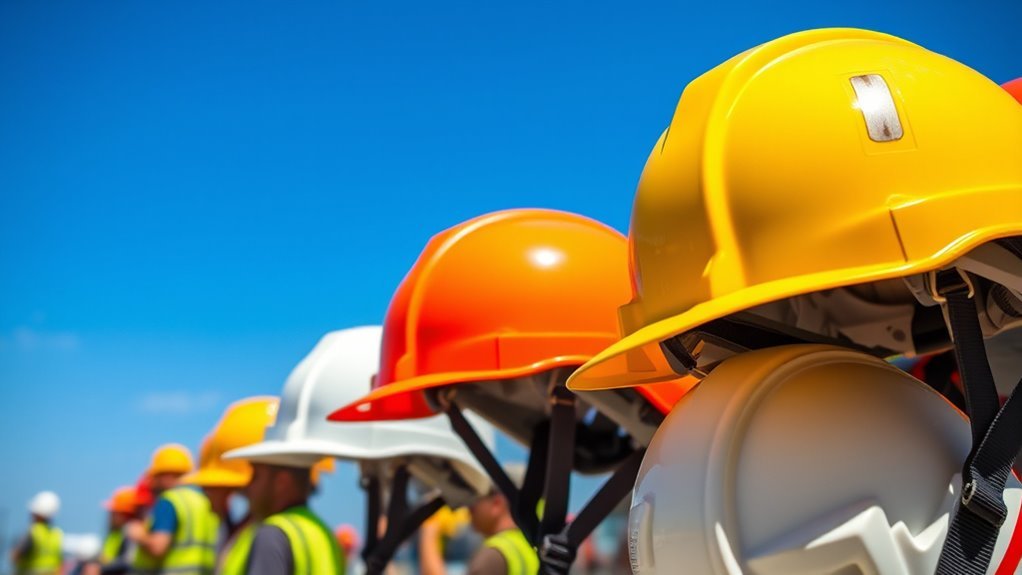
When choosing a construction helmet, it’s essential to take into account impact resistance standards to guarantee maximum protection against falling objects. Additionally, a comfortable fit can greatly affect your focus and performance on the job site. Make sure to look for features that enhance both safety and comfort, as they directly influence your overall work experience.
Impact Resistance Standards
Understanding impact resistance standards is essential for ensuring your safety on construction sites. When choosing a helmet, look for features that emphasize impact absorption, which determines how well a helmet can protect you from falling objects. Helmets are typically tested using standardized testing methods that assess their ability to withstand impacts without compromising structural integrity. The most common standards include ANSI/ISEA Z89.1 and EN 397, which provide guidelines on impact performance. Check for certifications that indicate the helmet meets or exceeds these standards. A helmet with high impact resistance can greatly reduce the risk of head injuries, giving you the freedom to focus on your work without compromising safety. Always prioritize helmets that pass rigorous testing for ideal protection.
Comfort and Fit
Choosing a helmet that meets impact resistance standards is just the beginning; comfort and fit are equally important for long hours on the job. You’ll want to look for helmets with adjustable straps, allowing you to customize the fit for your head shape. A snug yet comfortable fit prevents slippage and distraction, enhancing your focus on the task at hand.
Additionally, foam padding is essential for maximizing comfort. Helmets with quality foam padding can absorb sweat and reduce pressure points, making it easier to wear for extended periods. Consider lightweight designs that won’t weigh you down. Ultimately, a well-fitted helmet with adjustable straps and adequate foam padding provides protection without sacrificing comfort, ensuring you stay safe and focused while you work.
Types of Helmets Used in Construction
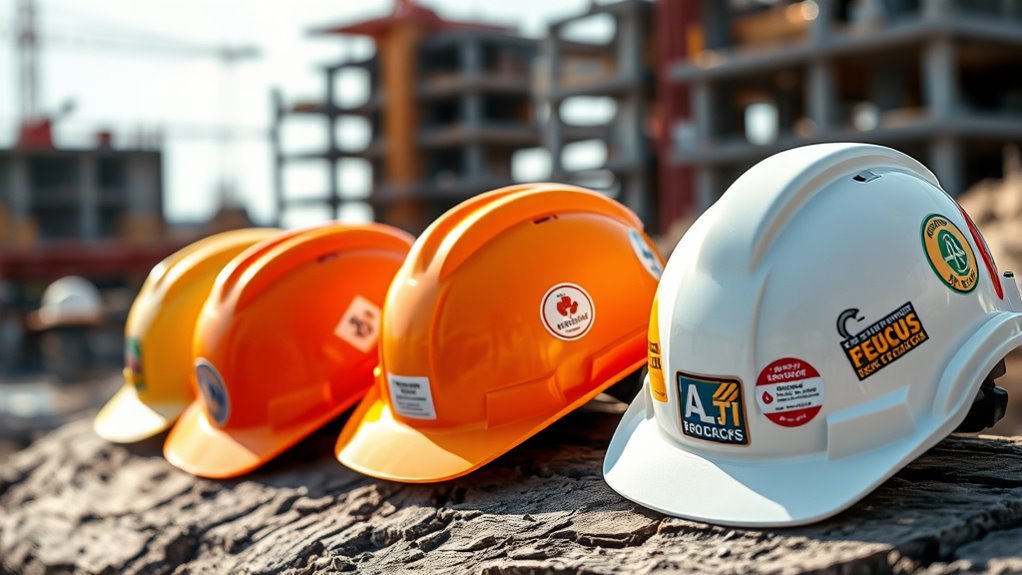
While safety is paramount on construction sites, the type of helmet you choose plays an essential role in protecting against various hazards. There are primarily two types of helmets used: hard hats and bump caps. Hard hats, typically made from durable helmet materials like high-density polyethylene or fiberglass, provide superior protection against falling objects. Bump caps, on the other hand, offer basic protection from minor bumps and scrapes but aren’t suitable for heavy-duty environments. Additionally, consider helmet accessories that enhance functionality, such as face shields, ear protection, and cooling liners. These accessories not only improve comfort but also expand your helmet’s protective capabilities, allowing you the freedom to focus on your work without compromising safety.
Top Brands for Construction Helmets
When it comes to choosing construction helmets, you’ll want to contemplate the top brands that lead the market in safety equipment. Companies like MSA, Honeywell, and Pyramex are known for their innovative helmet technologies that prioritize protection and comfort. Understanding the features and reputation of these manufacturers can help you make an informed decision for your safety on the job site.
Leading Safety Equipment Manufacturers
As you navigate the world of construction safety, knowing which brands excel in manufacturing helmets can considerably enhance your protection on the job site. Here’s a quick comparison of leading manufacturers known for their safety innovations and reliability:
| Brand | Safety Innovations | Notable Features |
|---|---|---|
| MSA | Advanced suspension | Lightweight design |
| Honeywell | Impact resistance | Integrated visors |
| Pyramex | Customizable options | High visibility |
When you choose a helmet from these trusted manufacturers, you’re not just buying a product; you’re investing in your safety. Each brand brings unique features to the table, ensuring you find the perfect fit for your work environment. Make informed choices for ultimate protection on the job.
Innovative Helmet Technologies
In today’s fast-paced construction environment, innovative helmet technologies play an essential role in enhancing safety and comfort for workers. Top brands are integrating smart technology into their helmets, allowing for real-time data collection and communication. Features like built-in sensors monitor environmental conditions, helping you stay aware of potential hazards. Moreover, augmented reality (AR) is revolutionizing the way you interact with your surroundings. Imagine wearing a helmet that displays critical information directly in your line of sight, such as project plans or safety alerts. This not only improves efficiency but also empowers you to make informed decisions on-site. Embracing these advancements can greatly elevate your safety and productivity, making your work experience more secure and enjoyable.
Safety Ratings and Certifications
Choosing a helmet with the right safety ratings and certifications is essential for construction workers. It guarantees you’re protected against potential hazards on-site. Look for helmets that meet established safety certifications, such as ANSI Z89.1 or CSA Z94.1. These rating systems evaluate the helmet’s ability to withstand impacts, penetration, and electrical hazards.
Here’s a quick reference table to help you understand the key safety certifications:
| Certification | Description | Impact Resistance |
|---|---|---|
| ANSI Z89.1 | American National Standards Institute | Yes |
| CSA Z94.1 | Canadian Standards Association | Yes |
| EN 397 | European Norm for industrial helmets | Yes |
| ISO 3873 | International Organization for Standardization | Yes |
Always prioritize helmets with these certifications to guarantee maximum safety on the job.
Comfort and Fit Considerations
A well-fitted helmet can make a significant difference in comfort during long hours on a construction site. To guarantee the best fit, pay attention to size adjustment features. Most helmets come with adjustable straps or a ratchet system, allowing you to customize the fit for your head shape. This guarantees the helmet stays securely in place without excessive pressure.
Additionally, consider the padding materials used inside the helmet. High-quality padding not only enhances comfort but also absorbs sweat, keeping you cool throughout the day. Look for moisture-wicking or breathable options to maximize your comfort. Remember, a comfortable helmet isn’t just about fit; it’s about allowing you the freedom to focus on your work without distraction. Prioritize comfort for peak performance on-site.
Maintenance and Care Tips for Helmets
Proper maintenance and care of your helmet is essential to guarantee its longevity and effectiveness. By following these tips, you can extend your helmet’s lifespan and make sure it performs when you need it most:
- Regular Cleaning: Use mild soap and water to clean your helmet. Avoid harsh chemicals that can degrade materials.
- Inspect for Damage: Frequently check for cracks or dents. If you notice any, consider replacing the helmet.
- Store Properly: Keep your helmet in a cool, dry place, away from direct sunlight, which can weaken the materials.
- Replace Padding: Over time, the padding can wear out. Replace it as needed to maintain comfort and protection.
Frequently Asked Questions
How Often Should Construction Helmets Be Replaced?
You should replace construction helmets every 2 to 5 years, depending on usage and exposure to harsh conditions. Some might think their helmet still looks fine, but helmet safety is vital; even small cracks or wear can compromise protection. Follow replacement guidelines provided by manufacturers, and inspect your helmet regularly for any signs of damage. Prioritizing your safety helps guarantee you can work freely and confidently in any environment.
Can I Personalize My Construction Helmet With Stickers?
Yes, you can personalize your construction helmet with stickers, but you should keep safety regulations in mind. Helmet customization shouldn’t compromise the helmet’s integrity or visibility. Make sure the stickers don’t obstruct any safety labels or features, and avoid using heavy materials that could affect the helmet’s performance. It’s a great way to express your personality while ensuring you stay safe on the job site. Always prioritize safety above aesthetics!
Are There Helmets Specifically for Women in Construction?
Yes, there are helmets specifically designed for women in construction, much like tailored suits that fit just right. These helmets often boast features that cater to women’s safety, including adjustable sizing, lighter materials, and stylish designs. You’ll find options that combine functionality with comfort, ensuring you can work confidently while staying safe. Just like any protective gear, it’s essential to choose a helmet that meets safety standards and fits your unique needs.
What Is the Average Lifespan of a Construction Helmet?
The average lifespan of a construction helmet is about 3 to 5 years, depending on use and maintenance. To guarantee safety, regularly inspect your helmet for cracks or wear and follow helmet maintenance tips, like cleaning it properly. Remember, helmets must meet specific safety standards, so if you notice any damage or if it’s older than five years, it’s time to replace it. Staying safe means staying informed and proactive about your gear.
Do Helmets Come in Different Sizes for Different Head Shapes?
Oh sure, because your head’s just a one-size-fits-all kind of deal, right? Thankfully, helmets do come in different sizes tailored for various head shapes. You’ll find options with fit adjustments that allow you to customize the comfort and security of your helmet. Whether you’ve got a round noggin or an elongated dome, there’s a helmet out there that’ll sit just right, keeping you protected while you embrace your freedom on the job site.
